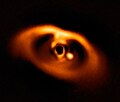Super-puff
A super-puff is a type of exoplanet with a mass only a few times larger than Earth's but with a radius larger than that of Neptune, giving it a very low mean density.[1] They are cooler and less massive than the inflated low-density hot-Jupiters.[1]
The most extreme examples known are the three planets around Kepler-51 which are all Jupiter-sized but with densities below 0.1 g/cm3.[1] These planets were discovered in 2012 but their low densities were not discovered until 2014.[2] Another example is Kepler-87c.[1]
One hypothesis is that a super-puff has continuous outflows of dust to the top of its atmosphere (for example, Gliese 3470 b), so the apparent surface is really dust at the top of the atmosphere.[2] Another possibility is that some of the super-puff planets are smaller planets with large ring systems, like HIP 41378 f.[3]
Formation hypotheses
The anomalous mass-to-radius ratio of super-puff planets was first interpreted as evidence for the presence of substantial hydrogen-helium envelopes formed billions of years ago within the protoplanetary disk.[4][5][6] In this long-term formation scenario, such envelopes would be prone to erosion through atmospheric escape processes, suggesting that maintaining extremely low densities over gigayear timescales would be difficult.[7][8][9][10][11] The persistence of known super-puffs has therefore motivated alternative models of envelope formation and retention.
References
[edit]- ^ a b c d The Featureless Transmission Spectra of Two Super-Puff Planets, Jessica E. Libby-Roberts, Zachory K. Berta-Thompson, Jean-Michel Desert, Kento Masuda, Caroline V. Morley, Eric D. Lopez, Katherine M. Deck, Daniel Fabrycky, Jonathan J. Fortney, Michael R. Line, Roberto Sanchis-Ojeda, Joshua N. Winn, 28 Oct 2019
- ^ a b "Astronomers Confirm the Existence of Planets That Have the Lightness of Cotton Candy". 20 December 2019.
- ^ "These So-Called 'Super-Puff' Worlds Could Be Exoplanets with Rings". Discover Magazine. Retrieved 11 January 2020.
- ^ Lee, E. J.; Chiang, E. (2016). "Breeding super-Earths and birthing super-puffs in transitional disks". The Astrophysical Journal. 817: 90.
- ^ Chachan, Y.; Lee, E. J.; Knutson, H. A. (2021). "Radial gradients in dust-to-gas ratio lead to preferred region for giant planet formation". The Astrophysical Journal. 919: 63.
- ^ Hanf, B.; Kincaid, W.; Schlichting, H.; Cappiello, L.; Tamayo, D. (2025). "Orbital migration through atmospheric mass loss". The Astronomical Journal. 169: 19.
- ^ Gao, P.; Zhang, X. (2020). "Deflating super-puffs: Impact of photochemical hazes on the observed mass–radius relationship of low-mass planets". The Astrophysical Journal. 890: 93.
- ^ Chachan, Y.; Jontof-Hutter, D.; Knutson, H. A.; Adams, D.; Gao, P.; et al. (2020). "A featureless infrared transmission spectrum for the super-puff planet Kepler-79d". The Astronomical Journal. 160: 201.
- ^ Cubillos, P.; Erkaev, N. V.; Juvan, I.; Fossati, L.; Johnstone, C. P.; et al. (2017). "An overabundance of low-density Neptune-like planets". Monthly Notices of the Royal Astronomical Society. 466: 1868–1879.
- ^ Thao, P. C.; Mann, A. W.; Feinstein, A. D.; Gao, P.; Thorngren, D.; et al. (2024). "The featherweight giant: Unraveling the atmosphere of a 17 Myr planet with JWST". The Astronomical Journal. 168: 297.
- ^ Wang, L.; Dai, F. (2019). "Dusty outflows in planetary atmospheres: Understanding 'super-puffs' and transmission spectra of sub-Neptunes". The Astrophysical Journal Letters. 873: L1.
